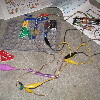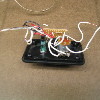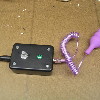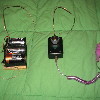Toy hacking
 |
 |
 |
 |
A few weeks ago we bought a new vibrator at Babeland. We were looking for something with good power that’s also portable. The Silk Touch Egg fit the bill. It’s powerful and portable.
There is an old engineering proverb that says, “Faster, Better, Cheaper — choose two of the above”. There are tradeoffs to everything. In this case, the motor goes like Gangbusters for about 10 minutes and then it starts to stumble. The little AAA batteries just don’t last long enough.
I checked the Energizer web site. They have data sheets on their different batteries. For the AAA Energizers, the data sheet shows that the total capacity of the battery depends strongly on the discharge rate. At 25mA draw, you can get 1,200mAh out of it, but at 400mA you only get about 400mAh. So I hooked up my little multimeter to it. Turns out my meter only reads current up to 250mA, because it pegged immediately. So we know the current draw is over 250mA. And this definitely puts the batteries into the ‘short-life’ range. And according to the graphs on the second page, at that level of discharge, we should see the voltage start to drop in a fraction of an hour, which was what we saw.
So, bein’ a geek, I started thinking about rigging up a bigger battery pack for it. The simplest thing to do would have been to put an external battery pack on it and just use the existing control. But the control has five pulsed modes that we’re not interested in. We just want the continuous mode. And the speed control is a little thumbwheel that’s kind of hard to use. So I figured I could just build my own speed control unit and attach that to a battery pack.
So I borrowed Lucinda’s Snap Circuits set for testing. I set up a basic NPN transistor circuit to control the motor speed. I experimented with different components. Then I got some actual components from my electronics junk box, just wiring everything together with alligator clips on the floor. After a few tries, I settled on a basic configuration. The transistor I used for the main speed control is a bit oversized for this. It’s rated at something like 40W, and this circuit is only dealing with about 1-2W. But that’s all right. It was just sitting in my junk box.
I had a little Radio Shack ‘project box’, so I used that for the case. I had to buy a volume control and knob, a diode, an LED for a power indicator, as well as a tiny little circuit board to mount stuff on. Then I had to cut the circuit board down to get it to fit into the box. Everything was so packed in that I had to put electrical tape on all the connectors to keep things from shorting out. But in the end, I got it to fit. The batteries are just mounted on a little piece of plywood. I’ll get a digital camera case or something like that for them to live in.
Power comes from either a D-cell three-pack, or from a 5VDC power supply that I found in my junk box. So it can run with or without an outlet. And either way, it’s pretty powerful.


February 6th, 2007 at 9:51 am
What was the total cost of the project? This is a perfect example of why I wish I were better with electronics & circuitry. It bums me out that vibes of this size aren’t designed to be rechargeable. Between vibrators & bike lights, both of which use up their charge pretty quickly, there’s potential to go through A LOT of batteries.
February 6th, 2007 at 10:50 am
I probably spent about $10-15 on parts at Radio Shack. The plug-in power supply I just had in my junk box. But it was just some assorted plugs and jacks, one transistor, one diode, one resistor, an LED, and a volume control.
February 11th, 2007 at 8:11 am
Just please tell me that you didn’t get the thing out and begin expounding on the excitement of the project at an inopportune moment…;)
February 11th, 2007 at 10:46 am
Heh. But it’s no different than when I built a transistor throttle for my model trains…
September 14th, 2007 at 3:57 pm
Wow. I bow down before the monolith of both your devotion and your geekdom.
Rock on with your self.
kissykiss,
chelsea g